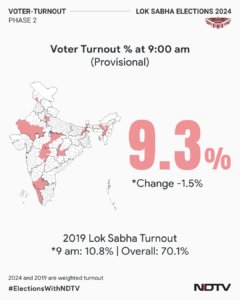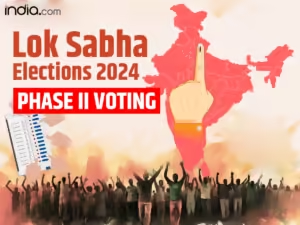Explore the highlights of India’s 2024 Phase 2 elections in our latest blog, delving into regional dynamics, technological integration, voter turnout, emerging trends, and implications for the nation’s democratic future. Discover the evolving political landscape, voter participation, and the role of women in shaping India’s electoral narrative. Join us as we analyze the significance of these elections and their implications for the world’s largest democracy.”
Table of Contents
ToggleIntroduction
: The Indian democratic juggernaut rolls on with the nation’s electoral machinery conducting the Phase 2 elections in 2024. As the world’s largest democracy, each election cycle in India captivates millions, shaping the country’s political landscape and influencing global perspectives. In this blog, we delve into the highlights of India’s 2024 Phase 2 elections, exploring the significant developments, emerging trends, and their implications.
Historical Context: Before dissecting the 2024 Phase 2 elections, it’s essential to understand the historical backdrop. India’s political narrative is rich with diversity, from its federal structure to its vibrant multiparty system. Over the years, elections have been a testament to the country’s commitment to democracy, showcasing the power of the ballot and the voice of its billion-plus citizens.
Phase 2: Key Features and Highlights
-
Regional Dynamics:
- Phase 2 witnessed electoral battles unfolding across various states, each with its unique socio-political dynamics. From Uttar Pradesh to Maharashtra, the electoral landscape showcased a blend of regional issues, caste equations, and local aspirations.
- In Uttar Pradesh, the battleground of Indian politics, the Phase 2 elections witnessed fierce contests, with major parties vying for supremacy. The state’s electoral significance stems from its sheer size and demographic diversity, making it a crucial determinant of national politics.
- Maharashtra, another key state, presented an intriguing political narrative with alliances, defections, and realignments shaping the electoral discourse. The Maharashtra elections offered a glimpse into the evolving dynamics of coalition politics and the quest for power corridors in the state.
-
Technological Integration:
- The 2024 elections showcased India’s increasing reliance on technology in the electoral process. From voter registration to polling booth management, technology played a pivotal role in ensuring transparency, efficiency, and accessibility.
- Digital platforms and social media emerged as crucial battlegrounds for political messaging and voter outreach. Parties leveraged digital campaigns, data analytics, and targeted communication to engage with voters and shape public opinion.

-
Voter Turnout and Participation:
- Despite challenges posed by the ongoing pandemic and logistical constraints, Phase 2 witnessed robust voter turnout across constituencies. The enthusiastic participation of voters underscored the resilience of India’s democratic ethos and the enduring spirit of electoral democracy.
- The Election Commission’s efforts to enhance voter awareness, ensure COVID-19 safety protocols, and facilitate smooth polling operations contributed to the success of Phase 2 elections.
-
Emerging Political Trends:
- Phase 2 elections offered insights into emerging political trends and voter preferences. Issues such as economic revival, healthcare infrastructure, employment generation, and social justice resonated with voters, shaping their electoral choices.
- The electoral outcomes reflected a nuanced understanding of regional aspirations, identity politics, and governance issues. Parties that effectively addressed these concerns gained traction among voters, signaling a shift in traditional political equations.
-
Women’s Participation:
- A notable highlight of the Phase 2 elections was the increased participation of women voters and candidates. From rural hinterlands to urban centers, women exercised their franchise in large numbers, asserting their agency in the electoral process.
- Political parties across the spectrum fielded more women candidates, reflecting a growing recognition of the importance of gender representation in politics. The enhanced visibility of women leaders and their active involvement in campaigning marked a significant step towards gender inclusivity in Indian politics.

Implications and Way Forward
The 2024 Phase 2 elections in India offer valuable insights into the evolving contours of Indian democracy. As the electoral saga continues, it is imperative to analyze the outcomes, address electoral challenges, and chart a course towards inclusive governance and participatory democracy. With each election, India reaffirms its commitment to democratic ideals, reaffirming the power of the ballot to shape the nation’s destiny. As the world watches, India’s electoral journey serves as a beacon of hope, inspiring nations to embrace the principles of democracy and uphold the sanctity of free and fair elections.
Conclusion
The Phase 2 elections of India in 2024 were not just a political event but a celebration of democracy, diversity, and resilience. As the nation marches ahead on its democratic path, the electoral process remains a cornerstone of its collective aspirations and aspirations. The 2024 elections reaffirm India’s faith in democracy and its unwavering commitment to building a stronger, more inclusive nation for generations to come.
Disclaimer:
The information provided in this blog is for general informational purposes only. While we strive to keep the information up to date and accurate, we make no representations or warranties of any kind, express or implied, about the completeness, accuracy, reliability, suitability, or availability with respect to the blog or the information, products, services, or related graphics contained in the blog for any purpose. Any reliance you place on such information is therefore strictly at your own risk. In no event will we be liable for any loss or damage including without limitation, indirect or consequential loss or damage, or any loss or damage whatsoever arising from loss of data or profits arising out of, or in connection with, the use of this blog. Through this blog, you are able to link to other websites that are not under the control of our platform. We have no control over the nature, content, and availability of those sites. The inclusion of any links does not necessarily imply a recommendation or endorse the views expressed within them. Every effort is made to keep the blog up and running smoothly. However, we take no responsibility for, and will not be liable for, the blog being temporarily unavailable due to technical issues beyond our control.





